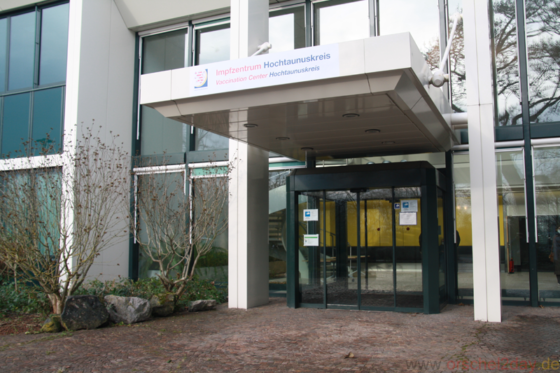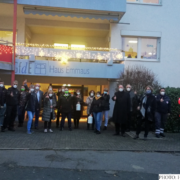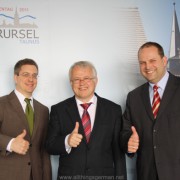Last week I was given the chance to take a look around the new vaccination centre, that has been set up in Bad Homburg in an office building once used by Hewlett-Packard.
Located next to a busy by-pass, the building is actually only 200m from the nearest bus stop with buses every 15 minutes at peak times, and 300m from the nearest U-Bahn station. Looking at the aerial photograph, it appears to have round 260 car parking spaces, and the car park will also be home to an area for dogs to stay whilst their owners are having their vaccinations.

Inside the building, we were shown around by the deputy district administrator Thorsten Schorr, the head of the local disaster control agency Carsten Lauer, and Dr. med. Dipl.-Jur. Nikolaos Sapoutzis from the local public health authority.
The whole centre has been set up within three weeks, and will remain there for the next 250 days, although this may be extended. This is one of the reasons to use this type of building and not a sports hall, so that they are not blocked next year for other uses. One of the other reasons is its close proximity to the motorway exit, allowing the vaccine to be delivered by lorry as efficiently as possible.
Between 1,140 and 1,200 people should be vaccinated every day when the centre is in operation, which will be for 15 hours every day, between 7am and 10pm, Monday to Sunday, with staff working in two shifts. It only takes about 15 minutes to complete the vaccination procedure, but there is additional waiting time at the end of this, so the plan is to vaccinate around 76 people each hour.
The appointments will be handled centrally by the regional government for Hessen, and further details on this were not available at the time of the visit. On arrived, patients will have their temperature measured and anyone whose temperature is too high will be taken to a separate area for a doctor to decide whether or not they can enter rest of the building for vaccination, or whether they will be turned away.
After the documents have beenj checked, patients proceed to the red waiting area. If they are being accompanied, then the person accomanying them will have to go to a separate waiting area. There will be staff on hand to help people with mobility problems and others in the hallways to explain where to go.
The red waiting area is split into two halves, one for those wishing to have a consultation with a doctor before the vaccination, and one for those who wish to forego this. This is followed by the blue area, where the formel registration takes place, before proceeding to the yellow waiting room directly before the vaccination area itself.
The vaccination area is made up of a row of 12 cubicles which are accessible from two sides. The patient enters from one side, with the medical staff entering from the other. There will be one doctor per 3 cubicles, with the injection being given by medically trained staff with at least 3 years training behind them. Two of the cubicles are larger for wheelchair users, and an additional three are set aside for people with special needs. From the medical side of the cubicles, the vaccine will be delivered from the in-house pharmacy, which itself is linked by a goods lift to the loading bay where the vaccine will be delivered.
There is an additional row of 16 cubicles for increase capacity as necessary, and mobile teams will also be in operation to visit care homes.
One of the other advantages of this building over large halls being used in some towns is that Hewlett-Packard installed sound absorption material in their ceilings, so it is very quiet in the cubicles.
After the vaccine has been given, patients continue to the green waiting area where they wait for between 20 and 30 minutes, in case they have an allergic reaction. Here, medical staff will be on hand in case anything happens, and even have a defibrillator at their disposal. There is a separate entrance for ambulance crews, and the ambulance station is only 2 minutes away should they be necessary.
Otherwise, if everything is fine, then patients are free to go and the whole procedure should have taken between 45 and 60 minutes.
There will be 70 people working in the vaccination centre on each shift, with around half of these being medical personnel. The staff have their own entrance and the use of the building’s cantine. The local authority is still in the process of recruiting them.
The building is already being guarded around the clock, and the police (who also accompanied the press on the tour) have been involved in planing the safeguards that will be in place.
As can be seen on my photos, all the signs are in both German and English, and should the IT system crash at any time, there will be an analogue backup system on hand to ensure that delays are kept to a minumum.
It is impotant to stress, however, that only those who have received notification of their appointment will be vaccinated. Anyone just turning up at the centre will be turned away. And whilst Thorsten Schorr hopes that as many people as possible will take up the opportunity of receiving the vaccination, it will not be compulsory.
Now all they need is the vaccine.







[…] whilst the number of vaccine units available is not enough to put the vaccination centre into full operation, it is being using as a starting point for mobile teams visiting care homes. […]